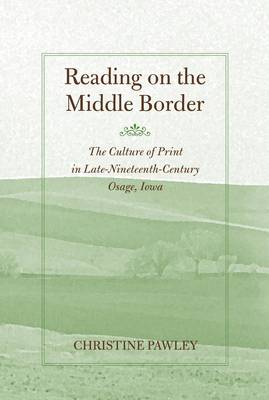
- Afhalen na 1 uur in een winkel met voorraad
- Gratis thuislevering in België vanaf € 30
- Ruim aanbod met 7 miljoen producten
- Afhalen na 1 uur in een winkel met voorraad
- Gratis thuislevering in België vanaf € 30
- Ruim aanbod met 7 miljoen producten
Zoeken
Reading on the Middle Border
The Culture of Print in Late-Nineteenth-Century Osage, Iowa
Christine Pawley
€ 39,45
+ 78 punten
Omschrijving
Reading is an everyday activity so taken for granted that it seems virtually invisible. In spite of its ubiquity in modern life (or perhaps because of its familiarity), scholars have only recently begun paying attention to its development as a social practice. During the nineteenth century, an evolving print culture made reading an essential part of Americans' daily routines. To date, the history of American reading practices has tended to focus on middle-class white people living in northeastern cities before 1876. Reading on the Middle Border shifts the focus to the Midwest and broadens the base of economic classes studied. Christine Pawley investigates the use of print by ordinary Americans in the small, rural community of Osage, Iowa--the town that shaped Hamlin Garland--analyzing primary source material on education, religious life, a reading club, and business affairs. A major section of her study focuses on the public library, an institution that provides a valuable window into the reading practices of men and women of various ages, classes, ethnicities, and religions. An extensive database of library circulation and accessions information, combined with federal and state census data, sheds light on the elusive issue of Who read what? Pawley explores the ways print confirmed or challenged people's economic, social, and religious world, and asks what values print expressed or confronted. She also raises questions relating to modes and contexts of reading, distinguishing between groups and individuals. The picture of print in Osage is complex and defies reduction, but by placing print in a community context and viewing printed materials as an expression of activities, not mere artifacts, Pawley enhances our understanding of the role of reading in American culture.
Specificaties
Betrokkenen
- Auteur(s):
- Uitgeverij:
Inhoud
- Aantal bladzijden:
- 280
- Taal:
- Engels
- Reeks:
Eigenschappen
- Productcode (EAN):
- 9781558497825
- Verschijningsdatum:
- 20/01/2010
- Uitvoering:
- Paperback
- Formaat:
- Trade paperback (VS)
- Afmetingen:
- 152 mm x 229 mm
- Gewicht:
- 412 g

Alleen bij Standaard Boekhandel
+ 78 punten op je klantenkaart van Standaard Boekhandel
Beoordelingen
We publiceren alleen reviews die voldoen aan de voorwaarden voor reviews. Bekijk onze voorwaarden voor reviews.











